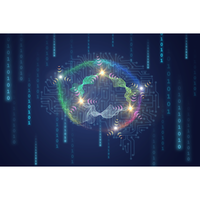Abstract
Variational quantum circuits (VQCs) built upon noisy intermediate-scale quantum (NISQ) hardware, in conjunction with classical processing, constitute a promising architecture for quantum simulations, classical optimization, and machine learning. However, the required VQC depth to demonstrate a quantum advantage over classical schemes is beyond the reach of available NISQ devices. Supervised learning assisted by an entangled sensor network (SLAEN) is a distinct paradigm that harnesses VQCs trained by classical machine-learning algorithms to tailor multipartite entanglement shared by sensors for solving practically useful data-processing problems. Here, we report the first experimental demonstration of SLAEN and show an entanglement-enabled reduction in the error probability for classification of multidimensional radio-frequency signals. Our work paves a new route for quantum-enhanced data processing and its applications in the NISQ era.
8 More- Received 2 July 2020
- Revised 1 March 2021
- Accepted 25 March 2021
DOI:https://doi.org/10.1103/PhysRevX.11.021047
Published by the American Physical Society under the terms of the Creative Commons Attribution 4.0 International license. Further distribution of this work must maintain attribution to the author(s) and the published article’s title, journal citation, and DOI.
Published by the American Physical Society
Physics Subject Headings (PhySH)
 Viewpoint
Viewpoint
Quantum Machine Learning for Data Classification
Published 1 June 2021
Quantum machine-learning techniques speed up the task of classifying data delivered by a small network of quantum sensors.
See more in Physics
Popular Summary
Future quantum computing could solve a wide range of classically intractable problems in data analysis, optimization, and simulation. A fully fledged quantum computer requires a large number of fault-tolerant quantum bits and processing units, but at present, only noisy intermediate-scale quantum (NISQ) devices are available. An emerging way forward joins NISQ hardware with classical machine learning, giving rise to promising hybrid quantum-classical algorithms capable of tackling complex problems. But NISQ hardware still falls short of what is needed to achieve a quantum advantage in practical applications. Here, we experimentally demonstrate how NISQ hardware can enjoy a quantum advantage in real-world scenarios where sensors acquire data.
We use classical machine learning to tailor the quantum entanglement shared by a network of sensors such that the error probability in classifying their acquired data becomes substantially lower than what separable classical sensors can do. This hybrid quantum-classical scheme—coined “supervised learning assisted by an entangled sensor network” (SLAEN)—thereby demonstrates a quantum advantage. In the experiment, entangled states are produced by a quantum circuit configured by a classical machine to classify global features of the signal acquired by three radio-frequency sensors. The classical machine and the quantum circuit are trained on known radio-frequency signals to obtain the optimal configuration.
While this experiment addresses the problem of entanglement-enhanced classification of radio-frequency signals, SLAEN can incorporate different genres of sensors, thereby reaping near-term quantum advantages in a variety of realms. For example, a network of entangled sensors could be trained to precisely identify molecular species for chemical sensing, to enable ultrasensitive inertial navigation, or to facilitate early disease detection and diagnostics for health care.


 Viewpoint
Viewpoint

